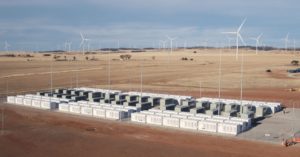As renewable energy demands soar, the need for efficient, low cost, large-scale energy storage systems is also rising. A lithium metal production technology produces lithium batteries that have been identified as a major part of the future of any renewable energy transition. Their implementation in electric mobility and projects of various scales has shown off just how versatile they can be.
From powering electric vehicles to supporting an entire electrical grid, batteries have quickly become the energy storage medium of choice. This has been reflected by the massive investments within the battery storage industry in which lithium batteries are a major draw. Current predictions indicate that the worldwide investment in batteries is set to surpass $620 billion by 2040, making the industry one of the fastest-growing sectors in the world.

Emerging from Darkness
There are two elements in the global transition to renewable energy. The first is the generation of electricity, which typically comes from sources such as solar or wind and is transmitted onto power grids for immediate use. However, at times when energy generation ceases, such as at night for solar or on calm days for wind, we revert to fossil fuels. Therefore, the second element is the storage capabilities of renewable energy so that we can use solar and wind energy, even when it is not sunny or windy at that exact moment. This is where lithium batteries and large scale energy storage systems come into play.
Large-scale lithium batteries first received ample attention after Elon Musk proposed to fix South Australia’s electricity grid issues in 2016. The state’s aging energy infrastructure was powered mostly by fossil fuels, and although South Australia was expanding its renewable energy sector, it had no large-scale energy storage facilities. During a very severe weather event, several transmission lines were knocked out of action and a large portion of the state’s wind farms shut down to protect themselves. With South Australia running out of power sources, they turned to coal-based power plants in nearby states. These power plants were unable to cope with such a sudden spike in energy demand and tripped, plunging South Australia into darkness.
As the state recovered from the blackout, Elon Musk offered to build a lithium battery storage facility that would be capable of acting as South Australia’s backup power supply. Met with mixed reactions, Musk’s project was finished ahead of time and immediately paid dividends. In the course of its short lifespan, the battery storage facility has generated a profit and saved South Australia and neighboring states from blackouts several times as it was able to recognize a drop in power availability and react to fill the demand within seconds. Elon Musk and South Australia have shown the world how to efficiently store renewable energy.

Since then, utility-scale energy storage projects have been more prevalent. Decreasing costs have made them an attractive option for utility companies looking to capitalize on the renewable energy market. In the United States, lithium battery storage capabilities have increased from 96.9 kW/h in 2014 to 649.1 kW/h in 2017 (an over 500% increase). During the same time period, costs associated with developing renewable energy projects have plummeted. With renewable energy costs expected to continue falling, utility companies are beginning to embrace lithium batteries.
Editor’s Pick – Related Articles:
 “Envelio: Helping to integrate renewable energy sources into the grid”
“Envelio: Helping to integrate renewable energy sources into the grid”
 “Power OffGrid: Innovating the energy market in Somalia”
“Power OffGrid: Innovating the energy market in Somalia”
Follow the Leader
Nevada’s largest utility company, NV Energy, has recently announced a massive solar energy project that will be paired with lithium battery storage facilities in three locations across the Silver State. Set to produce close to 1,200MW of energy coupled with close to 600MW in storage capabilities, this is one of the largest projects in the United States so far. With this project, NV Energy’s goal is to double its renewable energy output and transition away from fossil fuels as it works towards its 100% renewable energy target. This comes on the heels of Nevada’s own recent energy policy changes, with the state now requiring that utility companies source at least 50% of their energy from renewable sources by 2030. However, federal policy has not been as quick to adapt.

In 2018, the Federal Energy Regulatory Commission (FERC) passed a rule to ensure that large-scale batteries are introduced into current power grids across the United States. However, the FERC did not specify the usage regulations behind them. Both independent system operators and regional transmission organizations stand to benefit from using newly integrated lithium batteries within their grids, but there is confusion regarding how each entity’s batteries can be used. Further regulations will be needed to streamline the decision-making process behind the use of battery systems, but the fact that their integration is now a matter of federal policy is a big win for utility companies, renewable energy providers and consumers. Large-scale lithium batteries are the future of the energy grid. They promote renewable power generation, reduce carbon emissions and provide a more secure power grid.
While federal policy-making can be slow to adapt, local governments have been moving along with the trends within the energy sector. Puerto Rico has embraced renewable energy as its primary power source and battery storage is also set to play a vital role in the island’s microgrid project. Earlier in the year, Hawaiian Electric announced a renewable energy and battery storage project that would add 260MW of solar power production and over 1,000MWh of storage to the grid. Large scale projects in Arizona and California have also boasted the use of batteries and renewables and have helped usher in a new era in energy security and low-carbon power generation. Whether they are used for electric vehicles or large scale power storage, these batteries will change the way we produce and consume energy.










